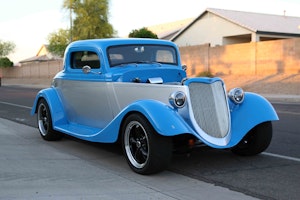Media | Articles
We Break, Then (Kind Of) Fix What We Broke, in the Lotus’ Heater Box
Last week I detailed the successful de-mousing of the heater box in my recently-purchased 1969 Lotus Elan +2. Once the box was cleaned and the rest of the under-dash area was deigned to be mouse-free, I re-installed the box, wrestled the dashboard back into place, tested all the switches and controls, and was horrified when I broke the lever off the arm that rotates the heater flap.

To appreciate what happened and how I fixed it, I need to describe the function of the heater and ventilation cables that are used in pretty much any car that doesn’t have climate control with servo-controlled heater flaps. These push-pull control cables are like bicycle cables in that they’re metal cables inside a housing, but there’s an important distinction. Bicycle cables are made from twisted thin strands of metal to make them highly flexible, which is what allows them to be clamped along the curved run of the handlebars and to function when you steer. But their flexibility also means that they can’t push. They can only pull.
They work because the brake and gear-changing components on a bike have springs in them. When you squeeze the brakes, the cables pull the sides of the calipers together, but when you let go, the springs in the calipers pull them back apart. In contrast, a push-pull control cable is made of a thick single strand, stiff enough to push as well as pull the thing at the other end without the complication of a spring to return it to a resting position. The downside is that because the cable is stiff, it’s not nearly as flexible as a multi-strand cable, and thus the bend radii can’t be as tight.
Push-pull control cables also are used in a variety of small gas engine applications like lawnmowers and snowblowers. There’s often a pull-out knob at the user end which pulls the cable, which then moves a lever to open up a choke or move a throttle plate. But because the lever is often pulling something that rotates in a circular arc, the far end of the cable needs to be free to pivot so it doesn’t bend. This pivoting is often accomplished by use of a threaded barrel-shaped ferrule with a hole in the middle for the cable to pass through, and screws that pinch the cable. The ferrule sits in a circular hole, thus allowing it to swivel relative to the lever.

But the barrel ferrule isn’t the only way to do it. There’s a particular type of push-pull control cable that has a roughly 0.2-inch circular loop at one or both ends. The spring-like circular winding snaps over a post that has a bulge near the top, thus allowing it to move a lever while the post pivots within the loop. The bulge prevents the loop from sliding off the post once installed. I’ve always called these “Bowden cables” because that’s what they’re called in the vintage BMW world. I now see that Wikipedia disagrees, saying that that a Bowden cable is any sheathed control cable. So I guess the generic term is the ungainly “loop-end push-pull control cable.”
Marketplace
Buy and sell classics with confidence

The Lotus’ heater box has two flaps. One selects whether air goes to the footwell, dashboard, or windshield. The other opens and closes the flap for the chamber where the heater core is. They’re both controlled by loop-end push-pull cables. The loop ends are on the levers on the side of the box. The other ends—the ones that go to the dashboard control levers—are held in place by ferrules, allowing the cable lengths to be adjusted, though the dashboard has to be partially removed to reach them. For this reason, there are fine adjusters, not unlike the ones on bicycle brake lever cables, on the side of the heater box. Although they can be reached with the heater box installed, it’s not easy, so if the heater box is out, it behooves you to adjust the cables as well as you can before putting it back in.

So here’s what happened. After I cleaned and rebuilt the heater box, I found that, no matter how I adjusted the heater flap cable, I couldn’t get a full range of motion out of the flap. The problem appeared to be in the cable itself, so I thought it might be internally kinked. More, when I examined the far end of the cable, I could see that it wasn’t an authentic loop-end control cable—it was a stiff cable with one end twisted into something resembling a loop. This obviously created play.

Finding a replacement cable initially wasn’t easy, as it hinged on knowing the correct search terms (this is how I came up with “loop-end push-pull control cable”). Eventually I found that MEI/Red Dot makes these cables in varying lengths with an assortment of ends. I needed the loop at one end and about 30 inches of length. The other end didn’t matter; I was going to cut it off. Even the housing didn’t matter—I needed to reuse the old one, as the adjusters at the end were captured in a fitting welded to the box. TruckAC, PartDeal, and eBay had a good variety. For about $30, I found one that looked like it would work.
When the new cable arrived, I removed the old one. I could see where less-than-free movement had caused the cable to kink internally. No wonder it didn’t feel smooth or give the flap a full range of movement.

I lubricated the new cable, snaked it through the existing sheath, slid the near end through its ferrule, snapped the loop end over the post on the heater lever (which required a lot more force to push it down over the bulge at the top of the post than I expected), cut it a few inches long just in case, and adjusted it until I had the full range of motion of the heater flap. I then tested the fan by wiring it to a battery and had it spinning while I moved both flaps to make sure nothing hit or buzzed. Everything worked.

I should add that the bulge on the post that held the loop end initially confused me. At first I thought that I’d bought a cable whose loop was too tight, and that the cable that was originally on the post was missing some little clip to hold it in place. This issue of clips spread to another location on the heater box. The rods that controlled the two flaps in the heater box were in fact missing little C-clips that slid into grooves on their ends, a fact that I discovered when I first reassembled the box and both of these rods had nothing to stop them from sliding back inside. I went to my local hardware store, found little C-clips that were the right size, and installed them.

When I installed the heater box in the car, a few things went wrong. The first was that the bend radius of the cables seemed uncomfortably tight. I looked at the photos I’d taken, and they showed that the cables exit from the right side of the dashboard levers, but are attached to the left side of the box, so they have to make two turns. I verified on the Lotus Elan forum that this was correct, and tried to orient them so nothing would get kinked. When I was convinced that the control levers felt like they were operating smoothly, I reattached them to the back of the lovely wood dashboard with their four tiny screws, verified smooth operation, then carefully moved the wood dash into its final position.

But once the dash was fully forward and ready to be screwed back in, when I rechecked the heater lever, it only moved about halfway. The problem turned out to be that I’d left too much extra cable poking through the end of the barrel ferrule, and with everything in place, it was poking into the back of the dash. D’oh! Careful tipping of the dash and reaching in with a pair of cutters to trim an inch off the end of the cable fixed it.
I fully buttoned-up the dash. This included attaching the vent and defroster hoses underneath, reattaching a relay that screwed to the right side of the heater box, and tucking wiring back in place. One final time, I operated the heater and vent sliders to make sure they weren’t binding up.
And again, the heater slider only moved about halfway. Damn, I thought. It couldn’t be the same problem. I’d cut plenty off the end of the cable. While testing, I didn’t feel like I was anywhere close to forcing things when the slider suddenly moved so freely that, like when you’re freeing a rusty nut and the wrench suddenly moves without your hearing that creeeeeee sound, I knew something was very wrong. I bent beneath the dash, looked at the heater flap lever, and was horrified to find that I’d broken the thing off.

What? How?
And more to the point… crap!!!
The “how” was soon revealed to be an astonishingly unlucky combination of two events. Remember that little clip I said I’d installed on the end of the heater flap rod so it couldn’t slide back inside the box? Remember that relay I said I’d reattached? The latter was preventing the rotation of the former. You can see the relay in the first photo above. Whether that was originally supposed to be its attachment point, I don’t know, but as the Brits would say, it sure bolloxed me up.

So, what to do about it?
I looked at both the broken piece as well as the left side of the box whose access was occluded by a spaghetti nest of 55-year-old wires. The piece was a lever arm that protruded off the side of a roughly half-inch “hub” that was press-fit onto the end of the heater flap rod. Even if a replacement for the piece was available, it was difficult to imagine installing it without removing the heater box. Even the more Hack Mechanic-like approaches of J-B Welding the arm back on, or securing it with brackets and screws, or making a new arm and holding it to the remaining hub by drilling and tapping holes, likely required removing the box, and the thought of doing that made me physically ill.

I posted the problem to social media. Several folks suggested 3D-printing a new part. On paper, this may sound like a good 3DP application. It is small and relatively simple, and it sits somewhere you can’t see, so finish and color are irrelevant. But that was never going to happen. I don’t own a 3D printer. I’m not facile with mechanical drawings. This isn’t a curtain ring you can download the file for. And since the failed one is an interference fit onto the heater flap shaft, 3D-printing one wouldn’t get around the problem of likely needing to remove the box in order to remove and install the part.
Part of my Hack Mechanic ethos is that I try not to spend more time and money on a problem than it deserves. I mean, the goal was de-mousing the heater box. I did that. Having the heater flap work properly would be nice, but this is an always-plumbed-on heater box that is reported to leak heat into the passenger compartment like a sieve regardless of whether the flap is open or closed. The solution for was installing a shut-off valve on the coolant line to the heater core, which I’ve already done. That’s the real heater control. The opening and closing of the flap is more of a wishful suggestion. For this and other reasons, pulling, fixing, and reinstalling would be the last thing I’d try, not the first.
Let me also say that I, who does a lot of air conditioning work, did wonder whether having to remove the mouse-infested heater box was an opportunity to install a/c in the Elan. When I searched on the Elan forum, I was quite surprised to learn that installing a modern climate-control box—in fact the same Vintage Air Mini system that people install in BMW 2002s—is a popular thing to do. I spent a blissful hour one night going down that rabbit hole, but emerged thinking that the car has many more pressing needs. And besides, retrofitting air is something I do after I’ve owned a car for a while, not when I’ve barely had the chance to drive it. However, if there was no other option for fixing this broken flap lever than pulling the box out, I was willing to look at the a/c issue again.
It seemed to me that the only avenue likely to work without removing the box was clamping something to the circumference of the remaining “hub” piece. Two weeks ago I waxed rhapsodic about the selection at my local True Value store. There’s something about being able to look at and hold options in your hand that you’re never going to get from paging through Amazon. I bought a few clamping options, including a clamp for a grounding rod. For something to replace the little post on the broken-off lever, I was delighted to find that kitchen cabinets use a standard 5mm dowel pin that’s remarkably similar in size. I bought a stand-alone pin as well as one on a little right-angle bracket.
My first attempt was to just hose-clamp the dowel pin to the circumference of the hub. This was simple, but didn’t have enough reach, and there was no obvious way to attach the loop to the back side of the post where the wire wouldn’t bend.
Next I tried the grounding clamp. This fit the hub beautifully, but it was big, and also had no obvious way to attach the post and allow the wire loop to rotate on it.

I thought “If only there was some sort of clamp where the clamp’s fastener could basically act as the lever arm itself, and to which I could directly attach the little post-on-a-bracket.” And then it came to me—a half-inch rubber-lined wire/hose-holding clamp that was so perfect that I had a Kill Bill “You didn’t think it would be this easy, did you?” moment.

I played with it and the post-on-angle-bracket, realized that I had to mount the bracket backward so the post faced the box, drilled an extra hole to get things aligned, and voila. The irregularity of the snapped-off part of the piece actually gives it more bite into the rubber. It works perfectly. For how long, I don’t know, but this isn’t a high-use high-torque application.

Plus, I’ve identified version 2.0—if there’s enough clearance, I can use a half-inch split collar. That would enable me to do whatever drilling and tapping for a lever arm is necessary on the workbench, then install the pieces.
So, it’s done. Unfortunately, winter weather, and with it, salted roads, have moved into New England. So the Elan +2 isn’t leaving the garage anytime soon.
But when it does, the both the heat, and the smell, will be sweet.
***
Rob’s latest book, The Best Of The Hack Mechanic™: 35 years of hacks, kluges, and assorted automotive mayhem, is available on Amazon here. His other seven books are available here on Amazon, or you can order personally inscribed copies from Rob’s website, www.robsiegel.com.



























A great hack and fix Rob and as with many of your articles, I learn new words like “facile”.
I think I would try to take a small block of aluminum and whittle away at it until it replicated the original pivot.
Take your time, just hand files, don’t try to complete it in one sitting!
Yankee Ingenuity at its very best Sir ! .
Who’d thunk an Adell clamp and a shelf bracket would do the trick ? .
I too often peruse those many drawers of hardware nirvana, sadly the local Big Box hardware stores have reduced them sharply .
I love your attention to detail and enthusiasm for tinkering, I grew up a farm boy in rural New England with always plenty of old rusty cars, trucks and farming implements to learn on .
-Nate
My Plus 2 heater box was sacrificed for a stereo installation decades ago. Thanks for the post and the opportunity to see what the heater installation looks like
My Plus 2 heater box was sacrificed for a stereo installation decades ago. Thanks for the opportunity to see what the installation is supposed to look like. My Plus 2 is a fair weather car. I don’t miss the heater.
With respect to proper parts terminology, aviation mechanics refer to the “rubber-lined cable/hose-holding clamp” as an Adel Clamp. They come in numbered sizes from tiny to large. If Tru-Value doesn’t have what you need go to the Aircraft Spruce & Specialty Catalog/website.